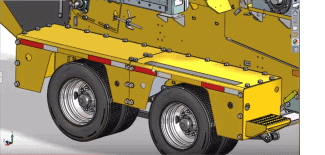Large Assemblies and How to Make Them Faster in SOLIDWORKS (Part 1)
 The term large assembly is a bit subjective. I often ask my customers a handful of questions, such as does your assembly take a long time to open, save, or rebuild? Does your assembly take a long time to make a drawing or work with drawings, does it hang your computer when you rotate, insert components, edit parts, or when adding mates? If they’ve answered yes to some or all of these questions, then you’re probably working with large assemblies.
The term large assembly is a bit subjective. I often ask my customers a handful of questions, such as does your assembly take a long time to open, save, or rebuild? Does your assembly take a long time to make a drawing or work with drawings, does it hang your computer when you rotate, insert components, edit parts, or when adding mates? If they’ve answered yes to some or all of these questions, then you’re probably working with large assemblies.
In this blog series, I’m going to talk about large assemblies and how to make them faster. Let’s get started.
I like to simplify this explanation and say that a large assembly is an assembly that uses most or all of your system resources and/or hurts your productivity, which is a big issue most users can relate to.
When you have a large assembly, and it takes forever to open and takes forever to save, this really cuts down on your ability to produce products throughout the day, and that’s something I’ll be addressing. I’ll show examples of what you can do to troubleshoot your large assemblies and cut down on the amount of time to save, the amount of time to open, and the amount of time to work with your assembly.
Now let’s take a look at an assembly that is slow and tedious to work with. When trying to work with assemblies that are sluggish, some common issues can be that the screen goes white and SOLIDWORKS stops responding.
What if a large assembly is slow to save? In the video below, my example took over a little over twelve minutes to save. That’s twelve minutes that I could have used to be doing engineering work or doing other tasks inside of SOLIDWORKS.
So what changes can be made to improve this large assembly performance? I can speed up my open time by opening my assembly locally instead of on a network drive and also because instead of opening the components resolved, I’m opening the components using Lightweight.
My assembly opened in just 40 seconds. If I make a few changes to the graphics, such as turning off shadows and shapes, turning off real view, and change the display to shaded, my assembly becomes more responsive.
It’s easy to zoom in and out, to rotate, and continue to get my job done without a setback.
Once these changes were made, my assembly only took twenty seconds to save, compared to over twelve minutes from earlier – a huge improvement.
In section 2 of this blog series, I’ll go into more detail on how to use these tools and more tips and tricks to make opening, using, and saving large assemblies faster. Stay tuned!
Reminder: When working with slow assemblies, make sure you reference this checklist to optimize your performance.
Have More Questions?
Our outstanding technical support team is here to help assist with all of your software needs.
More Tips & Tricks
SOLIDWORKS Frequently Asked Questions: Top 10 Tips and Tricks of 2017
Forgotten SOLIDWORKS Tools and Reasons to Use Them
Where is the SOLIDWORKS Command That Lets Me Do…?
About the Author
 Toby Schnaars began using the SOLIDWORKS Software on the ’98 plus release, in October of 1998. He began working for Prism Engineering (now Fisher Unitech) as an instructor and tech support engineer in 2001. He has fielded over 10,000 tech support cases and been the head instructor for over 200 SOLIDWORKS training classes. Toby is a regular presenter at users groups, technical summits, and SOLIDWORKS world. In 2003, in Orlando, FL, Toby won first place in SOLIDWORKS MODEL MANIA a modeling contest based on speed and accuracy. Toby hosts a free monthly webinar called “Toby’s Tech Talk” where you can tune in and get more tips and tricks on the SOLIDWORKS software.
Toby Schnaars began using the SOLIDWORKS Software on the ’98 plus release, in October of 1998. He began working for Prism Engineering (now Fisher Unitech) as an instructor and tech support engineer in 2001. He has fielded over 10,000 tech support cases and been the head instructor for over 200 SOLIDWORKS training classes. Toby is a regular presenter at users groups, technical summits, and SOLIDWORKS world. In 2003, in Orlando, FL, Toby won first place in SOLIDWORKS MODEL MANIA a modeling contest based on speed and accuracy. Toby hosts a free monthly webinar called “Toby’s Tech Talk” where you can tune in and get more tips and tricks on the SOLIDWORKS software.

 Blog
Blog